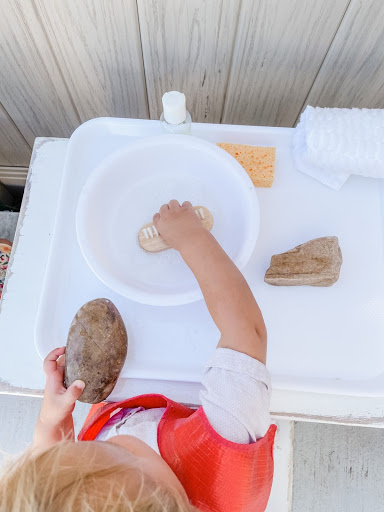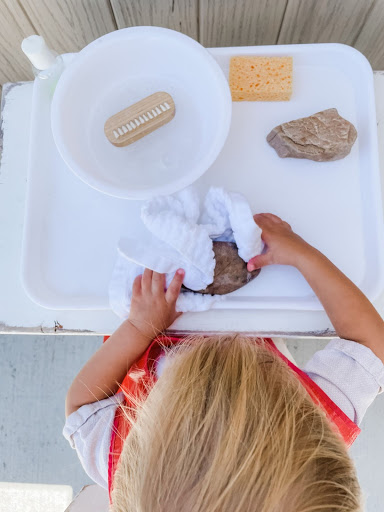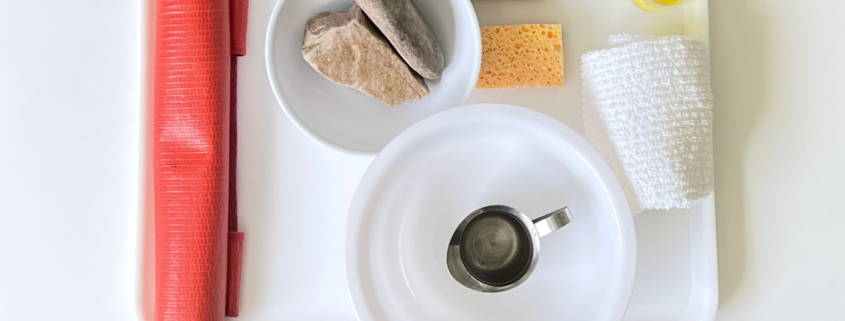Rock Washing Work
Rock Washing Work
Maria Montessori recognized and understood that children were eager to work, even when the work seems like a chore to adults. Their work is their play and while working, they are forming and developing foundations in organizational skills as well as intelligence. Washing and cleaning activities in the classroom or at home provide exactly what children need for development of concentration, independence, caring for the environment, becoming aware of order and sequencing and gaining control over their movements. And for kids, it’s just plain fun!
Rock washing is a variation of dishwashing. There are many different ways to practice the sequential steps of washing but rock washing is a favorite in our homes. Rock washing is a great way to satisfy a child’s need for sequential work and get your backyard or schoolyard rocks sparkling clean all at the same time! 😂
What You Will Need:
- Tray with lip or small dishwashing tub
- Bucket with water or other water source
- Empty bucket for dirty water
- Pitcher for scooping out water
- Bowl with rocks
- Bottle of soap, bar of soap or dispenser of liquid soap
- Sponge for cleaning up spills
- Scrubber for washing the rocks clean
- Towel for drying
- A work apron (we use a plastic one here but any kind of apron works. A cloth apron is great because it is a control of error.
- Allowing the child to feel that he/she is wet but any kind of work apron will work.)
Lesson:
Extend an invitation to the rock washing station to your child. Carefully and with intention, give a lesson to your child going through all the steps in the activity.
-
-
-
- Take the pitcher and fill it with water from the water bucket.
- Pour water into the large bowl.
- Choose a rock to place in the bowl.
- Squeeze soap in the bowl.
- Pick up the brush in dominant hand.

- Hold the rock in the water with your other hand.
- Begin to scrub the rock.

- Turn the rock over and repeat.
- When satisfied, rinse the brush in the water and shake out excess water.
- Put the brush back on the tray.
- Lay out the towel and place the wet rock on the towel for drying. Bring up the edges of the towel around the rock and rub or pat the rock dry.

- Pour the water into the empty bucket
- Take the bucket to the sink or if outside a designated area in your yard and pour the water out.
- Replace the items back where they were found.
- Ask your child, “would you like a turn?”
-
-
Give your child lots of time to explore and work with this material. Observe, observe, observe. If your child is missing some of the steps you gave him/her, give another lesson another day. Don’t intervene or interrupt unless they ask you for help. While they are working with this material and any other, they are gaining knowledge and learning through play.
Note: For Toddlers and younger children, we suggest using less steps. For instance, instead of having your child go to a bucket or water source to get water, have the water already inside the pitcher. Or instead of having the child dry the rock with a towel, have them place it in a bowl to dry outside. You can simplify however you would like and add more details or steps as your child shows readiness.
Here are a few other ideas of variations that your child just might love! Try one today!
Washing work Variations:
- washing dishes
- vegetable washing
- peeling eggs and washing
- scrubbing potatoes
- car washing
- horse, dinosaur, baby washing
- seashell washing
- brick washing
- toys or truck washing
The options and variations of washing work are endless. In our school, dishwashing is always available but we also have washing activities on the shelf that we rotate in and out for variation monthly or even weekly depending on our students interests and needs. Once you get the hang of setting up washing work, we know it will be a staple in your homes as well.




Leave a Reply
Want to join the discussion?Feel free to contribute!